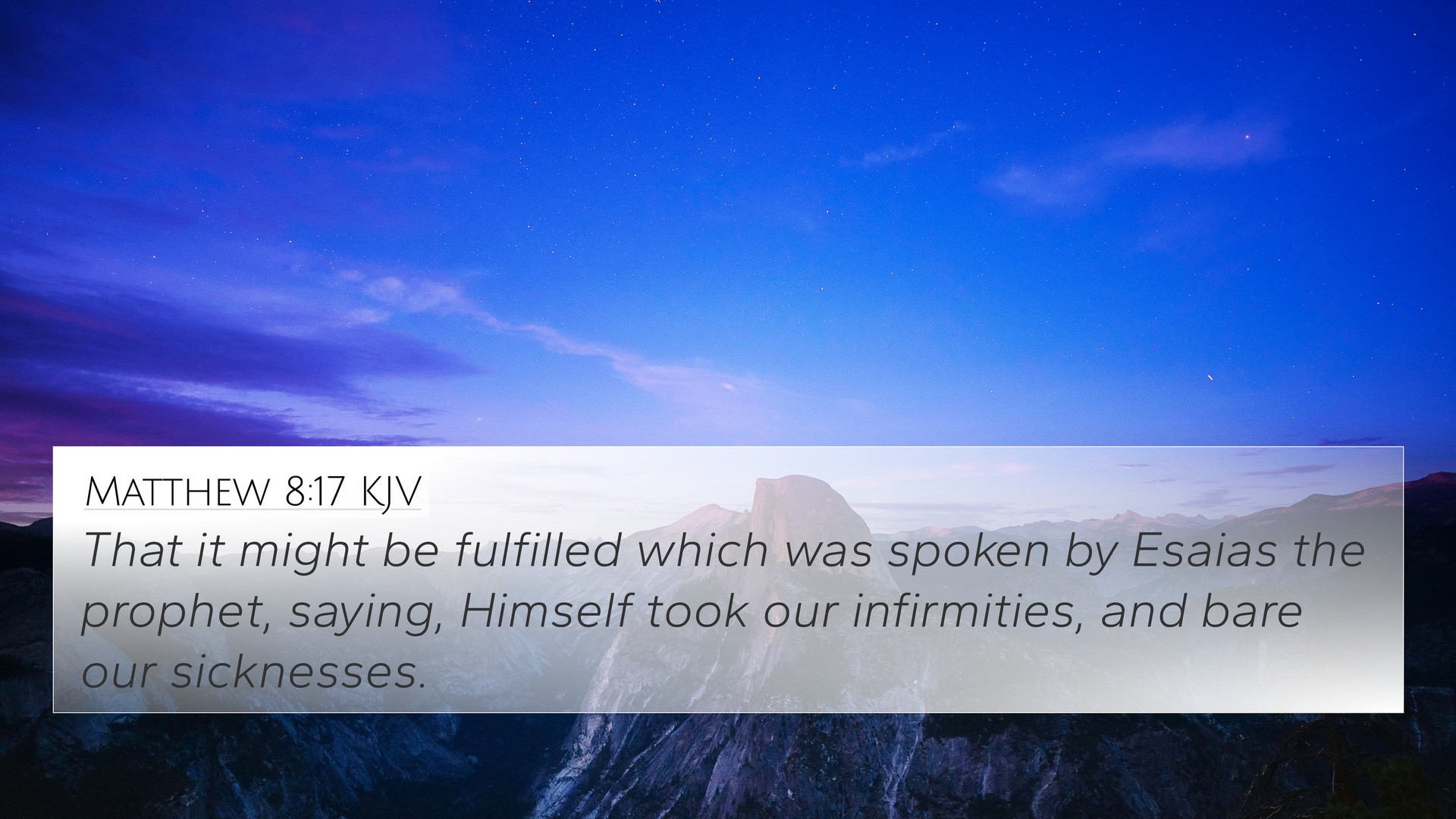Understanding Matthew 8:17 - A Comprehensive Analysis
Matthew 8:17 states: "That it might be fulfilled which was spoken by Isaiah the prophet, saying, He took our infirmities, and bare our sicknesses."
This verse is significant as it emphasizes the fulfillment of Old Testament prophecy by Jesus Christ. The act of Christ healing the sick serves as a powerful reminder of His divine authority and compassion.
Commentary Insights
Matthew Henry highlights that the miracles performed by Jesus, especially healing, were not merely acts of kindness but also served as a testament to His messianic identity. Healing the sick was a vital aspect of His ministry, proving that He was indeed the fulfillment of the prophetic words of Isaiah.
Albert Barnes points out that Matthew links this healing ministry directly to Isaiah 53:4, which refers to the suffering servant who would bear the sins and sorrows of many. This is essential in understanding that Christ's mission was to alleviate both physical and spiritual suffering.
Adam Clarke emphasizes that by taking upon Himself our infirmities, Jesus demonstrated His ability to empathize with human suffering. Thus, this verse serves to reassure believers of Christ’s compassion and willingness to bear their burdens.
Cross-References to Matthew 8:17
- Isaiah 53:4 - "Surely he has borne our griefs and carried our sorrows."
- 1 Peter 2:24 - "Who his own self bare our sins in his own body on the tree."
- Matthew 4:24 - "And his fame went throughout all Syria: and they brought unto him all sick people."
- Luke 4:18 - "The Spirit of the Lord is upon me, because he hath anointed me to preach the gospel to the poor."
- John 14:12 - "Verily, verily, I say unto you, He that believeth on me, the works that I do shall he do also."
- James 5:14 - "Is any sick among you? Let him call for the elders of the church."
- Matthew 9:35 - "And Jesus went about all the cities and villages, teaching in their synagogues, and preaching the gospel of the kingdom."
Thematic Connections
The healing miracles described in Matthew 8:17 underscore a broader theme, found often throughout the Gospels: the centrality of Christ as the great physician. This exposition leads us to consider the connections between the various Gospel accounts and how they articulate the importance of Jesus’ healing power.
Comparative Bible verse analysis between the Gospels provides insight into the multifaceted nature of Christ's ministry. By exploring Luke 8:43-48, where Jesus heals a woman with an issue of blood, we can see His sensitivity to individual suffering.
Thematic connections are expanded in John 5:6, where Jesus directly approaches a man who had been ill for thirty-eight years, demonstrating His authority over sickness and His intent to heal.
Lessons and Application
From Matthew 8:17 and its related cross-references, believers are encouraged to understand that Jesus actively takes on the burdens of humanity. This knowledge fosters a deeper trust in Jesus as redeemer and healer.
Scriptural cross-referencing helps to illuminate the continuity of God's message throughout the scriptures, showcasing how Jesus' earthly ministry was deeply rooted in prophecies and promises from the Old Testament.
Tools for Bible Cross-Referencing
For those seeking to engage with the Bible cross-reference system, the use of Bible concordances can facilitate “linking Bible scriptures” effectively. Resources such as the Bible cross-reference guide can provide further insights into thematic and topical studies.
Conclusion
Matthew 8:17 encapsulates a profound truth about Jesus’ nature and His fulfillment of Old Testament prophecy. As we analyze this verse alongside others, it becomes clear that Christ's healing is not just a physical restoration but also a spiritual one, emphasizing His role as our Savior. In navigating the connections between Bible verses, we discover a rich tapestry of interconnected themes that speak to God’s unchanging love and commitment to redemption.







